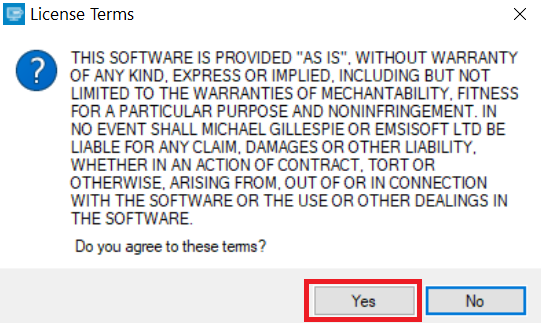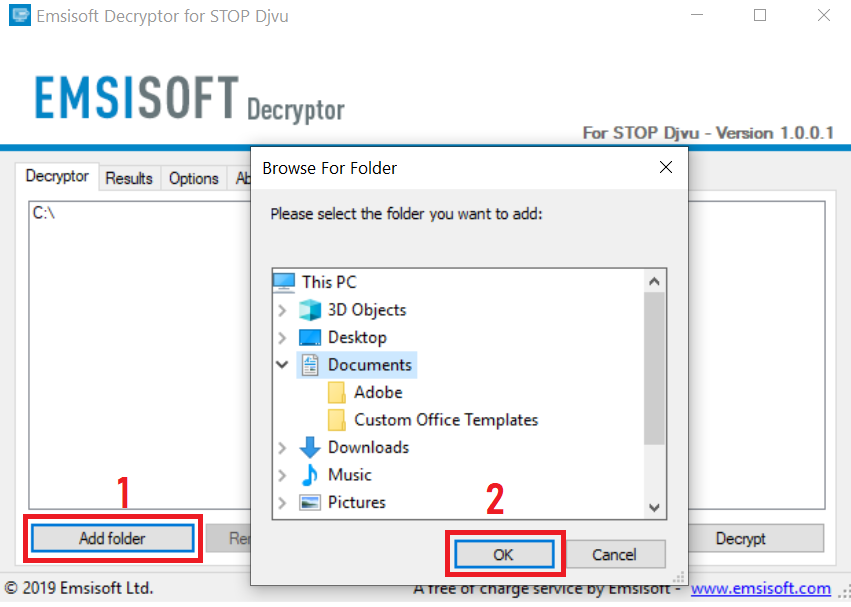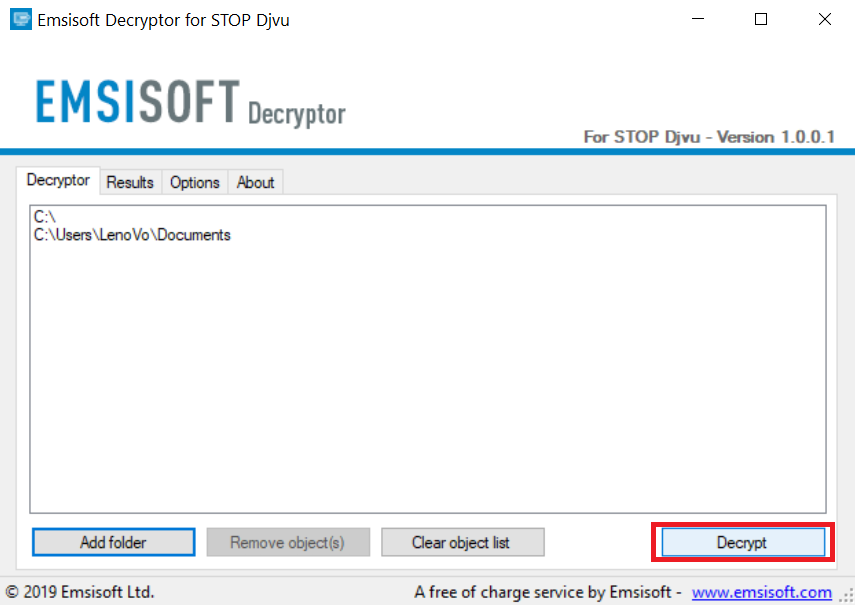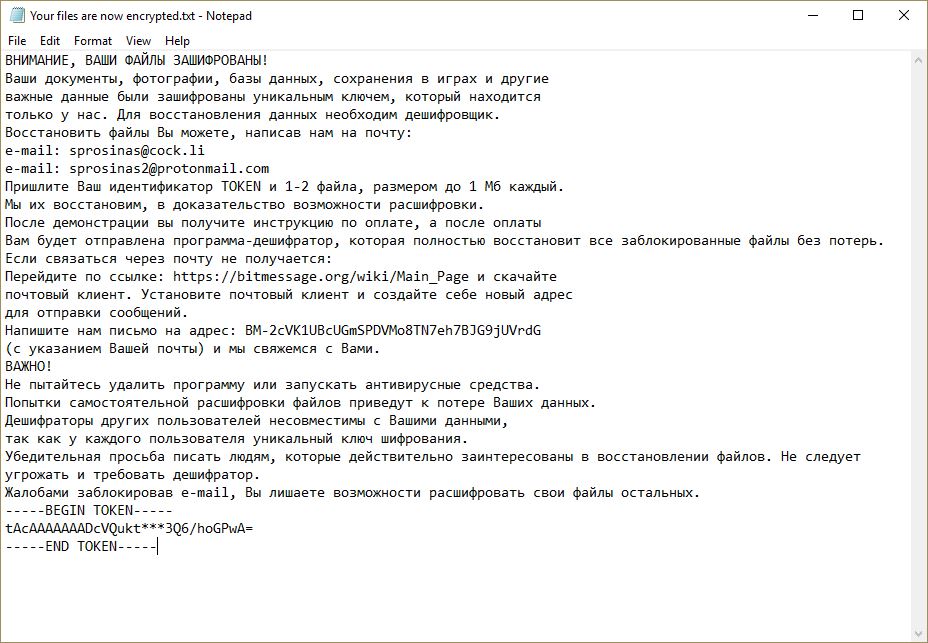This article will aid you to remove VegaLocker Ransomware. Follow the ransomware removal instructions provided at the end of the article.
VegaLocker Ransomware is one that encrypts your personal data with a strong cipher and demands money as a ransom to get it restored. The VegaLocker Ransomware will leave ransomware instructions as text file. Keep on reading the article and see how you could try to potentially recover some of your locked files and data.

Threat Summary
| Name | VegaLocker ransomware |
| Type | Ransomware, Cryptovirus |
| Short Description | The ransomware encrypts sensitive user files on your computer system and demands a ransom to be paid to allegedly recover them. |
| Symptoms | The ransomware will encrypt your files and leave a ransom note with payment instructions. |
| Distribution Method | Spam Emails, Email Attachments |
| Detection Tool |
See If Your System Has Been Affected by malware
Download
Malware Removal Tool
|
User Experience | Join Our Forum to Discuss VegaLocker ransomware. |
| Data Recovery Tool | Windows Data Recovery by Stellar Phoenix Notice! This product scans your drive sectors to recover lost files and it may not recover 100% of the encrypted files, but only few of them, depending on the situation and whether or not you have reformatted your drive. |

VegaLocker Ransomware – Distribution Techniques
The VegaLocker ransomware has been identified as a new threat in an ongoing attack campaign. It contains elements from several different threats which means that the hacker collective behind it has created a “fusion” of different viruses resulting in VegaLocker. This approach allows it to be spread using a wide variety of methods.
At the moment the bulk of the infections are done via vulnerability exploitation allowing the virus to access the target computers and use remote desktop software to login to them. Such attacks are primarily done in an automated manner which means that hundreds and potentially thousands of computers can be targeted at once.
Other delivery tactics can include the popular hacker strategies of sending out attached or linked files containing the VegaLocker ransomware in email phishing messages. They are sent to the targets by posing as legitimate notifications sent by well-known services and companies. The files will be advertised as important updates or installers that the users will need to run.
A similar mechanism is the creation of fake web sites which are created using a similar mechanism. They are made to copy the design, name, contents and other elements of well-known Internet pages and attempt to confuse the visitors into thinking that they have accessed a legitimate and safe domain. Similar sounding names and even security certificates may be used to make them seem as the real pages. Via the posted contents, links and multimedia elements the VegaLocker ransomware infection can be obtained.
Virus infections like this one can also be caused by interacting with malicious payload carriers, there are two popular variants:
- Infected Application Installers — The criminals can embed the installation scripts in setup files of popular software that are often downloaded by end users. They are made by taking the original files from the vendors and adding in the virus installation code.
- Infected Documents — The other mechanism is to create malicious documents that can be of any of the popular types: presentations, databases, spreadsheets and text documents. The virus installation code is made part of the macros that are inserted in them. When the documents are opened by the victim users a prompt will appear asking them to enable them which will lead to the infection.
Another large-scale strategy for delivering the VegaLocker ransomware is to make them part of the dropper programmed in browser hijackers. They are dangerous browser plugins which are widely available on the respective repositories. The criminal controllers will often use fake user reviews and developer credentials along with thrilling descriptions promising the users performance optimizations and new features addition.

VegaLocker Ransomware – Detailed Analysis
The code analysis reveals that the VegaLocker ransomware is programmed in the Delphi programming language and that it contains code from the Scarab ransomware family. It includes source code taken from other families as well: Amnesia, Gloverabe2 and etc. All of this leads to two primary possible causes:
- Own Creation — It is proposed that the same collective that is behind the attacks is responsible for its creation. They have taken the source code of all of these malware families and created the custom code by themselves.
- Custom Order — This thesis proposes that the VegaLocker ransomware is the result of a custom order on the dark underground markets. Once it is complete the hackers can use it to infect targets of their own choice.
Its interesting to note that it includes signature from a variety of different products, services and companies. This makes it very convenient to use with infected applications. The fact that these signatures are present can also bypass security software in certain cases. This is possible along with a dedicated module that is executed for this operation. Such include anti-virus software, virtual machine hosts, firewalls, debug environments and etc.
A list extracted from one of the captured samples reveals the following signatures under which it can be spread:
Habbo, Rebhip, The Qt Company Ltd, Microsoft Corporation, Delphi Libraries, SMART INSTALL MAKER, InnoSetup, James Jackson-South, Microsoft Visual C/C++ Libraries, libczmq3, Adobe Systems Incorporated, Mercury Interactive, NSIS, Splinterware Software Solutions and StockSharp LLC.
After the VegaLocker ransomware has been delivered it will start a series of scripts that will disable access to the boot recovery options. This makes manual user recovery guides no longer working as most of them rely on them.
Data deletion will also take place as the engine will scan and remove traces of System Restore Points, Backups and Shadow Volume Copies. When they have completed running the users will have to use a combination of an anti-spyware solution and data recovery program in order to effectively restore their systems.
What’s more dangerous is that this threat has been specifically programmed to evade virtual machine hosts. It will scan the memory and located any strings related to hypervisors or additions (such as drivers and utility software) that can reveal that the host is actually a part of a virtual machine installation. When such has been detected the virus will stop or may delete itself to avoid detection.
At this point the VegaLocker ransomware will have obtained the ability to modify all areas of the affected operating system. This will enable it to start even more processes, one of which is the data harvesting one. It is programmed to extract data that can be categorized into two main groups:
- Personal Information — The retrieved information can be used to directly expose the identity of the victims by acquiring strings such as their name, address, phone number, interests and any stored account credentials.
- Computer Information — The engine can harvest data about the computers which is useful for creating a distinct ID for each affected host. It is usually generated via an algorithm that takes its input from the user preferences, parts list of the installed hardware components and certain operating system environment values.
The next step is to cause changes to the Windows Registry. This means that not only the virus will insert values pertaining to itself, but also modify existing ones. This can lead to severe performance issues and the inability to launch certain programs or services. The affected software can exit with unexpected errors or behave improperly.
The ransomware has been found to be able to modify the Desktop.rdp configuration file which is used to configure the remote desktop sessions. This is especially useful when they are actively used by the hackers. The criminals need simply to add in their own account information which would allow them unrestricted access when Internet connectivity is available.
It has also been found to measure the computer’s performance which may be related to the ability to deliver additional payloads. Two of the most common ones are the following:
- Trojan Horse Infections — They are one of the most dangerous consequences of ransomware infections. They will establish a secure connection to a hacker-controlled server. Through it the hackers can overtake control of the machines, retrieve data before they are encrypted and spy on the victims in real-time.
- Cryptocurrency Miners — They will take advantage of the available system resources by computing complex mathematical tasks by downloading tasks from a special server called “pool”. The malicious script will watch the execution of the tasks and award digital currency when one of them is completed. The funds will be directly wired to their digital wallets.
It is very possible that future versions might use all of these instruments in order to carry out complex agenda. One of the most popular scenarios is to build a botnet network — it is used to recruit the infected computers to a worldwide network of “slaves”. They can be programmed to launch a rapid succession of network requests to a given host thus bringing it down. Large networks can be very effective against large companies or even government agencies.

VegaLocker Ransomware – Encryption Process
The VegaLocker ransomware will launch the relevant encryption operations when all modules have finished running. Like other similar threats it will use a built-in list of target file type extensions such as the following:
- Backups
- Archives
- Databases
- Images
- Music
- Videos
The ransomware note will be crafted in a file called Your files are now encrypted.txt which contains a message written in Russian:
ВНИМАНИЕ, ВАШИ ФАЙЛЫ ЗАШИФРОВАНЫ!
Ваши документы, фотографии, базы данных, сохранения в играх и другие
важные данные были зашифрованы уникальным ключем, который находится
только у нас. Для восстановления данных необходим дешифровщик.
Восстановить файлы Вы можете, написав нам на почту:
e-mail: sprosinas@cock.li
e-mail: sprosinas2@protonmail.com
Пришлите Ваш идентификатор TOKEN и 1-2 файла, размером до 1 Мб каждый.
Мы их восстановим, в доказательство возможности расшифровки.
После демонстрации вы получите инструкцию по оплате, а после оплаты
Вам будет отправлена программа-дешифратор, которая полностью восстановит все заблокированные файлы без потерь.
Если связаться через почту не получается:
Перейдите по ссылке: https://bitmessage.org/wiki/Main_Page и скачайте
почтовый клиент. Установите почтовый клиент и создайте себе новый адрес
для отправки сообщений.
Напишите нам письмо на адрес: BM-2cVK1UBcUGmSPDVMo8TN7eh7BJG9jUVrdG
(с указанием Вашей почты) и мы свяжемся с Вами.
ВАЖНО!
Не пытайтесь удалить программу или запускать антивирусные средства.
Попытки самостоятельной расшифровки файлов приведут к потере Ваших данных.
Дешифраторы других пользователей несовместимы с Вашими данными,
так как у каждого пользователя уникальный ключ шифрования.
Убедительная просьба писать людям, которые действительно заинтересованы в восстановлении файлов. Не следует угрожать и требовать дешифратор.
Жалобами заблокировав e-mail, Вы лишаете возможности расшифровать свои файлы остальных.
—–BEGIN TOKEN—–
tAcAAAAAAADcVQukt***3Q6/hoGPwA=
—–END TOKEN—–

Remove VegaLocker Ransomware and Try to Restore Data
If your computer system got infected with the VegaLocker ransomware virus, you should have a bit of experience in removing malware. You should get rid of this ransomware as quickly as possible before it can have the chance to spread further and infect other computers. You should remove the ransomware and follow the step-by-step instructions guide provided below.
- Step 1
- Step 2
- Step 3
- Step 4
- Step 5
Step 1: Scan for VegaLocker ransomware with SpyHunter Anti-Malware Tool



Ransomware Automatic Removal - Video Guide
Step 2: Uninstall VegaLocker ransomware and related malware from Windows
Here is a method in few easy steps that should be able to uninstall most programs. No matter if you are using Windows 10, 8, 7, Vista or XP, those steps will get the job done. Dragging the program or its folder to the recycle bin can be a very bad decision. If you do that, bits and pieces of the program are left behind, and that can lead to unstable work of your PC, errors with the file type associations and other unpleasant activities. The proper way to get a program off your computer is to Uninstall it. To do that:


 Follow the instructions above and you will successfully delete most unwanted and malicious programs.
Follow the instructions above and you will successfully delete most unwanted and malicious programs.
Step 3: Clean any registries, created by VegaLocker ransomware on your computer.
The usually targeted registries of Windows machines are the following:
- HKEY_LOCAL_MACHINE\Software\Microsoft\Windows\CurrentVersion\Run
- HKEY_CURRENT_USER\Software\Microsoft\Windows\CurrentVersion\Run
- HKEY_LOCAL_MACHINE\Software\Microsoft\Windows\CurrentVersion\RunOnce
- HKEY_CURRENT_USER\Software\Microsoft\Windows\CurrentVersion\RunOnce
You can access them by opening the Windows registry editor and deleting any values, created by VegaLocker ransomware there. This can happen by following the steps underneath:


 Tip: To find a virus-created value, you can right-click on it and click "Modify" to see which file it is set to run. If this is the virus file location, remove the value.
Tip: To find a virus-created value, you can right-click on it and click "Modify" to see which file it is set to run. If this is the virus file location, remove the value.
Before starting "Step 4", please boot back into Normal mode, in case you are currently in Safe Mode.
This will enable you to install and use SpyHunter 5 successfully.
Step 4: Boot Your PC In Safe Mode to isolate and remove VegaLocker ransomware





Step 5: Try to Restore Files Encrypted by VegaLocker ransomware.
Method 1: Use STOP Decrypter by Emsisoft.
Not all variants of this ransomware can be decrypted for free, but we have added the decryptor used by researchers that is often updated with the variants which become eventually decrypted. You can try and decrypt your files using the instructions below, but if they do not work, then unfortunately your variant of the ransomware virus is not decryptable.
Follow the instructions below to use the Emsisoft decrypter and decrypt your files for free. You can download the Emsisoft decryption tool linked here and then follow the steps provided below:
1 Right-click on the decrypter and click on Run as Administrator as shown below:

2. Agree with the license terms:

3. Click on "Add Folder" and then add the folders where you want files decrypted as shown underneath:

4. Click on "Decrypt" and wait for your files to be decoded.

Note: Credit for the decryptor goes to Emsisoft researchers who have made the breakthrough with this virus.
Method 2: Use data recovery software
Ransomware infections and VegaLocker ransomware aim to encrypt your files using an encryption algorithm which may be very difficult to decrypt. This is why we have suggested a data recovery method that may help you go around direct decryption and try to restore your files. Bear in mind that this method may not be 100% effective but may also help you a little or a lot in different situations.
Simply click on the link and on the website menus on the top, choose Data Recovery - Data Recovery Wizard for Windows or Mac (depending on your OS), and then download and run the tool.
VegaLocker ransomware-FAQ
What is VegaLocker ransomware Ransomware?
VegaLocker ransomware is a ransomware infection - the malicious software that enters your computer silently and blocks either access to the computer itself or encrypt your files.
Many ransomware viruses use sophisticated encryption algorithms to make your files inaccessible. The goal of ransomware infections is to demand that you pay a ransom payment to get access to your files back.
What Does VegaLocker ransomware Ransomware Do?
Ransomware in general is a malicious software that is designed to block access to your computer or files until a ransom is paid.
Ransomware viruses can also damage your system, corrupt data and delete files, resulting in the permanent loss of important files.
How Does VegaLocker ransomware Infect?
Via several ways.VegaLocker ransomware Ransomware infects computers by being sent via phishing emails, containing virus attachment. This attachment is usually masked as an important document, like an invoice, bank document or even a plane ticket and it looks very convincing to users.
Another way you may become a victim of VegaLocker ransomware is if you download a fake installer, crack or patch from a low reputation website or if you click on a virus link. Many users report getting a ransomware infection by downloading torrents.
How to Open .VegaLocker ransomware files?
You can't without a decryptor. At this point, the .VegaLocker ransomware files are encrypted. You can only open them once they are decrypted using a specific decryption key for the particular algorithm.
What to Do If a Decryptor Does Not Work?
Do not panic, and backup the files. If a decryptor did not decrypt your .VegaLocker ransomware files successfully, then do not despair, because this virus is still new.
Can I Restore ".VegaLocker ransomware" Files?
Yes, sometimes files can be restored. We have suggested several file recovery methods that could work if you want to restore .VegaLocker ransomware files.
These methods are in no way 100% guaranteed that you will be able to get your files back. But if you have a backup, your chances of success are much greater.
How To Get Rid of VegaLocker ransomware Virus?
The safest way and the most efficient one for the removal of this ransomware infection is the use a professional anti-malware program.
It will scan for and locate VegaLocker ransomware ransomware and then remove it without causing any additional harm to your important .VegaLocker ransomware files.
Can I Report Ransomware to Authorities?
In case your computer got infected with a ransomware infection, you can report it to the local Police departments. It can help authorities worldwide track and determine the perpetrators behind the virus that has infected your computer.
Below, we have prepared a list with government websites, where you can file a report in case you are a victim of a cybercrime:
Cyber-security authorities, responsible for handling ransomware attack reports in different regions all over the world:
Germany - Offizielles Portal der deutschen Polizei
United States - IC3 Internet Crime Complaint Centre
United Kingdom - Action Fraud Police
France - Ministère de l'Intérieur
Italy - Polizia Di Stato
Spain - Policía Nacional
Netherlands - Politie
Poland - Policja
Portugal - Polícia Judiciária
Greece - Cyber Crime Unit (Hellenic Police)
India - Mumbai Police - CyberCrime Investigation Cell
Australia - Australian High Tech Crime Center
Reports may be responded to in different timeframes, depending on your local authorities.
Can You Stop Ransomware from Encrypting Your Files?
Yes, you can prevent ransomware. The best way to do this is to ensure your computer system is updated with the latest security patches, use a reputable anti-malware program and firewall, backup your important files frequently, and avoid clicking on malicious links or downloading unknown files.
Can VegaLocker ransomware Ransomware Steal Your Data?
Yes, in most cases ransomware will steal your information. It is a form of malware that steals data from a user's computer, encrypts it, and then demands a ransom in order to decrypt it.
In many cases, the malware authors or attackers will threaten to delete the data or publish it online unless the ransom is paid.
Can Ransomware Infect WiFi?
Yes, ransomware can infect WiFi networks, as malicious actors can use it to gain control of the network, steal confidential data, and lock out users. If a ransomware attack is successful, it could lead to a loss of service and/or data, and in some cases, financial losses.
Should I Pay Ransomware?
No, you should not pay ransomware extortionists. Paying them only encourages criminals and does not guarantee that the files or data will be restored. The better approach is to have a secure backup of important data and be vigilant about security in the first place.
What Happens If I Don't Pay Ransom?
If you don't pay the ransom, the hackers may still have access to your computer, data, or files and may continue to threaten to expose or delete them, or even use them to commit cybercrimes. In some cases, they may even continue to demand additional ransom payments.
Can a Ransomware Attack Be Detected?
Yes, ransomware can be detected. Anti-malware software and other advanced security tools can detect ransomware and alert the user when it is present on a machine.
It is important to stay up-to-date on the latest security measures and to keep security software updated to ensure ransomware can be detected and prevented.
Do Ransomware Criminals Get Caught?
Yes, ransomware criminals do get caught. Law enforcement agencies, such as the FBI, Interpol and others have been successful in tracking down and prosecuting ransomware criminals in the US and other countries. As ransomware threats continue to increase, so does the enforcement activity.
About the VegaLocker ransomware Research
The content we publish on SensorsTechForum.com, this VegaLocker ransomware how-to removal guide included, is the outcome of extensive research, hard work and our team’s devotion to help you remove the specific malware and restore your encrypted files.
How did we conduct the research on this ransomware?
Our research is based on an independent investigation. We are in contact with independent security researchers, and as such, we receive daily updates on the latest malware and ransomware definitions.
Furthermore, the research behind the VegaLocker ransomware ransomware threat is backed with VirusTotal and the NoMoreRansom project.
To better understand the ransomware threat, please refer to the following articles which provide knowledgeable details.
As a site that has been dedicated to providing free removal instructions for ransomware and malware since 2014, SensorsTechForum’s recommendation is to only pay attention to trustworthy sources.
How to recognize trustworthy sources:
- Always check "About Us" web page.
- Profile of the content creator.
- Make sure that real people are behind the site and not fake names and profiles.
- Verify Facebook, LinkedIn and Twitter personal profiles.














